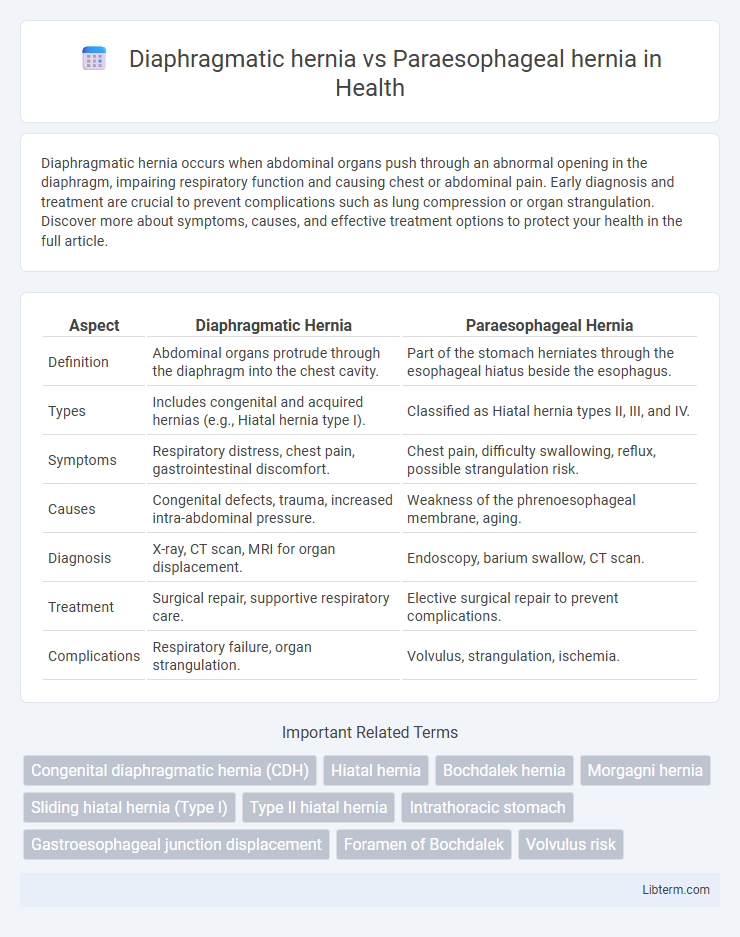Diaphragmatic hernia occurs when abdominal organs push through an abnormal opening in the diaphragm, impairing respiratory function and causing chest or abdominal pain. Early diagnosis and treatment are crucial to prevent complications such as lung compression or organ strangulation. Discover more about symptoms, causes, and effective treatment options to protect your health in the full article.
Table of Comparison
| Aspect | Diaphragmatic Hernia | Paraesophageal Hernia |
|---|---|---|
| Definition | Abdominal organs protrude through the diaphragm into the chest cavity. | Part of the stomach herniates through the esophageal hiatus beside the esophagus. |
| Types | Includes congenital and acquired hernias (e.g., Hiatal hernia type I). | Classified as Hiatal hernia types II, III, and IV. |
| Symptoms | Respiratory distress, chest pain, gastrointestinal discomfort. | Chest pain, difficulty swallowing, reflux, possible strangulation risk. |
| Causes | Congenital defects, trauma, increased intra-abdominal pressure. | Weakness of the phrenoesophageal membrane, aging. |
| Diagnosis | X-ray, CT scan, MRI for organ displacement. | Endoscopy, barium swallow, CT scan. |
| Treatment | Surgical repair, supportive respiratory care. | Elective surgical repair to prevent complications. |
| Complications | Respiratory failure, organ strangulation. | Volvulus, strangulation, ischemia. |
Introduction to Diaphragmatic and Paraesophageal Hernias
Diaphragmatic hernias occur when abdominal organs protrude through an abnormal opening in the diaphragm, often congenital or traumatic in origin. Paraesophageal hernias, a subtype of hiatal hernias, involve the stomach pushing through the esophageal hiatus beside the esophagus while the gastroesophageal junction remains in place. Both conditions compromise thoracic and abdominal structure integrity, leading to respiratory and gastrointestinal symptoms.
Anatomy and Types of Diaphragmatic Hernia
Diaphragmatic hernias involve the protrusion of abdominal contents through defects in the diaphragm, with common types including congenital Bochdalek and Morgagni hernias, characterized by posterolateral and anterior defects respectively. Paraesophageal hernias are a subtype of hiatal hernias where the stomach herniates alongside the esophagus through the esophageal hiatus without esophageal displacement. Anatomically, diaphragmatic hernias affect various regions of the diaphragm, whereas paraesophageal hernias specifically involve the esophageal hiatus, impacting the gastroesophageal junction's position and function.
Anatomy and Types of Paraesophageal Hernia
A diaphragmatic hernia involves the protrusion of abdominal contents through an abnormal opening in the diaphragm, often congenital, whereas a paraesophageal hernia specifically occurs when the stomach herniates through the esophageal hiatus beside the esophagus. Paraesophageal hernias are classified into four types: Type I (sliding hernia), Type II (pure paraesophageal hernia with the gastric fundus alongside the esophagus), Type III (mixed hernia combining sliding and paraesophageal components), and Type IV (hernia with additional organs such as colon or spleen within the thoracic cavity). Understanding these anatomical distinctions is critical for accurate diagnosis and targeted surgical repair strategies.
Etiology: Causes of Each Hernia
Diaphragmatic hernia primarily results from congenital defects in the diaphragm, such as Bochdalek or Morgagni hernias, or from trauma causing diaphragmatic rupture. Paraesophageal hernia occurs due to weakening of the phrenoesophageal membrane and increased intra-abdominal pressure, often linked to aging, obesity, or chronic straining. Understanding these distinct etiologies aids in accurate diagnosis and tailored treatment strategies for each hernia type.
Clinical Presentation: Signs and Symptoms
Diaphragmatic hernia commonly presents with respiratory distress, cyanosis, and mediastinal shift due to abdominal organ herniation into the thoracic cavity, often diagnosed in neonates. Paraesophageal hernia typically manifests in adults with symptoms such as chest pain, early satiety, and dysphagia, but may remain asymptomatic and only show complications like gastric volvulus or bleeding. Both hernias require careful clinical evaluation to differentiate based on symptomatology and imaging findings.
Diagnostic Modalities and Imaging
Diaphragmatic hernia is primarily diagnosed using chest X-rays and contrast-enhanced CT scans, which reveal abdominal contents protruding into the thoracic cavity, often alongside signs of lung compression. Paraesophageal hernia diagnosis relies heavily on barium swallow studies, esophagogastroduodenoscopy (EGD), and high-resolution esophageal manometry to assess anatomical displacement of the stomach alongside the esophagus and evaluate esophageal motility. Advanced imaging such as MRI or 3D CT reconstruction can provide detailed visualization of the hernia sac and adjacent structures, aiding in precise differentiation and surgical planning.
Complications Associated with Both Hernias
Diaphragmatic hernia complications include respiratory distress, pulmonary hypoplasia, and gastrointestinal obstruction, often resulting from abdominal organs herniating into the thoracic cavity. Paraesophageal hernia complications primarily involve gastric volvulus, strangulation, and obstruction, leading to ischemia or necrosis of the herniated stomach portion. Both hernias carry risks of compromised blood supply and require prompt diagnosis to prevent life-threatening outcomes.
Treatment Options and Surgical Approaches
Treatment options for diaphragmatic hernia often involve surgical repair to reposition abdominal organs and close the defect, with minimally invasive laparoscopic techniques preferred for reduced recovery time. Paraesophageal hernia typically requires surgical intervention to prevent complications like strangulation, utilizing laparoscopic fundoplication to restore the stomach's anatomical position and reinforce the diaphragmatic hiatus. Both conditions benefit from tailored approaches considering patient age, hernia size, and symptom severity to optimize outcomes and minimize recurrence rates.
Prognosis and Postoperative Outcomes
Diaphragmatic hernia prognosis varies depending on the size and organ involvement, with larger defects often leading to respiratory complications and longer hospital stays post-surgery. Paraesophageal hernia typically presents better postoperative outcomes due to less compromise of pulmonary function, though risks include recurrence and reflux symptoms. Surgical repair of both hernia types aims to reduce morbidity, but paraesophageal hernia repair generally shows lower rates of postoperative respiratory complications compared to diaphragmatic hernia surgery.
Prevention and Follow-Up Care
Preventing diaphragmatic hernia and paraesophageal hernia involves maintaining a healthy weight and avoiding activities that increase intra-abdominal pressure, such as heavy lifting and straining during bowel movements. Follow-up care for both conditions includes regular imaging studies like chest X-rays or CT scans to monitor hernia size and potential complications, alongside managing symptoms through dietary modifications and, if necessary, surgical intervention. Early detection and consistent monitoring reduce the risk of complications such as strangulation or GERD-associated esophagitis.
Diaphragmatic hernia Infographic

 libterm.com
libterm.com